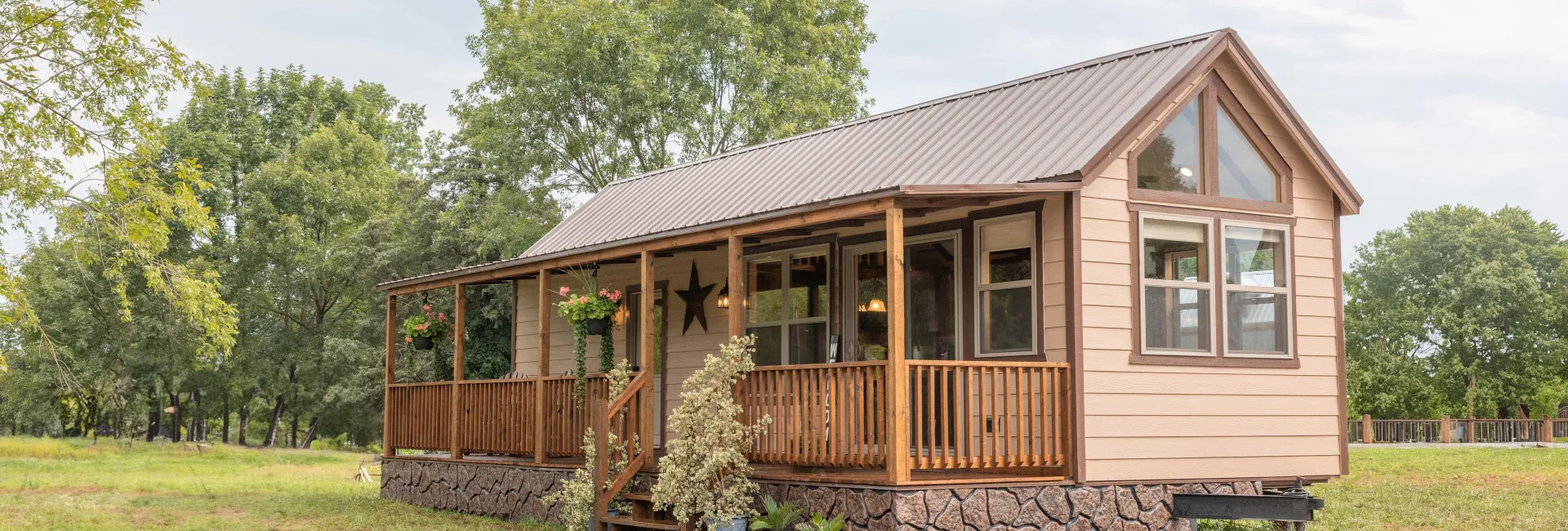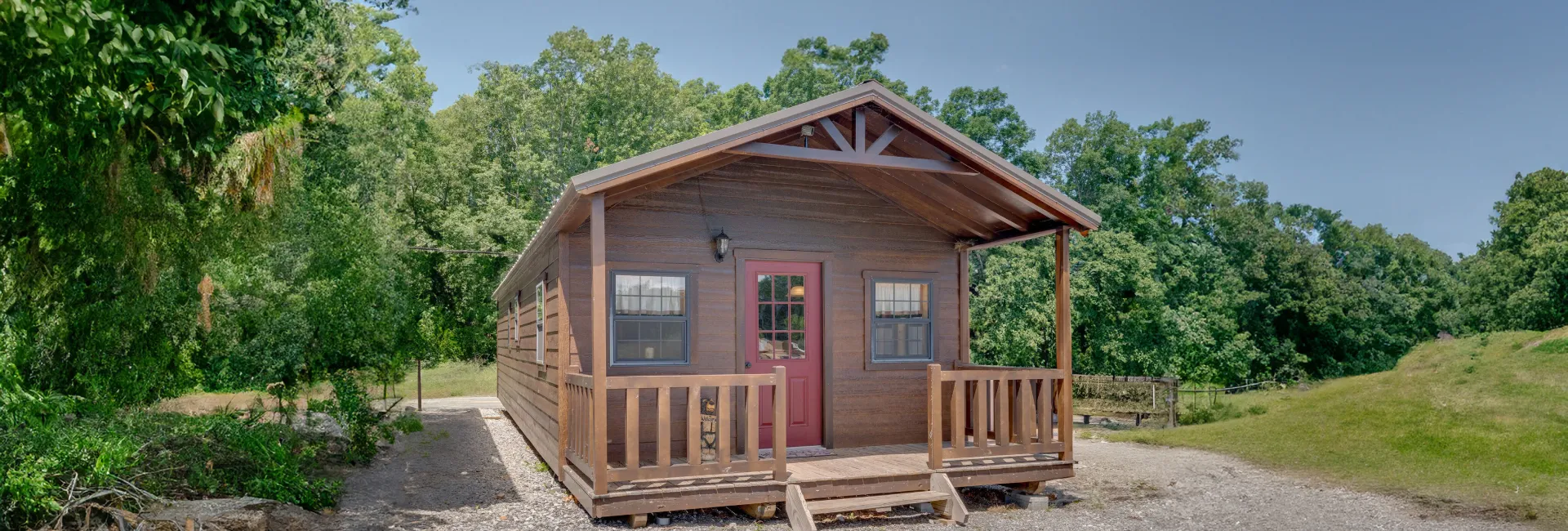At Trailhead Cabins, we’re passionate about helping people bring their rustic living dreams to life with custom-built modular cabin home and Park Model RVs. One of our most popular styles, our double wide modular cabin, showcase how we combine craftsmanship, planning, and precision to deliver a high-quality structure that’s nearly move-in ready by the time we leave the job site.
Table of Contents
Preparation for Modular Shipping
Our shipping process begins at the factory where our shipping team will meticulously prepare the modular home for shipment. For our larger homes (Double Wides) this is done by dividing the modular home into two sections, called Modules. Our double wide homes have a wall through the center of the home, called a Marriage Wall. The Marriage Wall makes that each module is a Box meaning there is a wall on all four sides of the module. Each module is then packaged for shipment, by using a heat shrink plastic to cover the openings to protect the interior of the home from rain or other elements. The modules are then loaded onto Modular Carrier Trailers that are used to transport the home to the Job site. After the home is craned onto the foundation, these trailers are brought back the Factory for using on the next delivery.
Modular Home Foundation Setup
The Foundation Building process begins before we even step foot on the property. This is done by a local foundation professional, hired by the client, and by the time we arrive with the modular home, the foundation is already in place, ready to support the cabin. To protect the base: we recommend you make sure the foundation crew completes the following items.
- Lay down a 12-inch plastic barrier between the wood and the concrete block to prevent moisture damage, and termite barrier.
- On top of that, install a 2x10 or 2x8 treated board known as the “Foundation Sill Plate”
- Secure the Foundation Sill Plate with 5-inch lag bolts paired with 2" x 2" plates for additional strength and durability at the connection points. Please note, it is very important that these anchors are in such locations that they do not interfere with the Band Board of the modular home. We can help with this, and provide the specs needed for these locations.
Crane Setup and Cabin Positioning
Next comes the heavy lifting—literally. Once the crane arrives and is leveled, we get to work on rigging the first section of the cabin. Even though our double wide cabins sit on a steel frame trailer (Modular Carrier Trailer) for transport, their foundation relies on wooden floor joists. To safely distribute the weight during the lift, we notch out the Band Board and run two steel cables beneath the structure. This method helps keep the cabin level as it’s lifted off the trailer.
With ground crew guiding the crane operator, the first half of the cabin is gently placed onto the foundation. Then, we repeat the process with the second half, carefully aligning everything to ensure a perfect fit.
Single Wide Modular Home Installation: Simple, Seamless, and Ready to Go
While our double wide cabins come together on-site in two pieces, our single wide cabins offer an even more streamlined setup. The delivery and crane process are virtually identical—minus the extra section—making it a fast and efficient installation for customers who want a complete, compact cabin solution.
When we arrive at the job site, the foundation is already prepped, and just like with our double wides, ready for the home to be placed on it, and fastened to it.
Once the crane is leveled and rigged, we run two cables under the single wide and notch the floor joists in just the right places to evenly distribute the weight. The unit is then lifted from the trailer and gently placed onto the foundation—fully assembled and complete.
The Hinged Roof System
Some of our double wide cabins are simply too tall to meet legal transport height limits. That’s where our hinged roof system comes into play. Prior to delivery, we fold the roof sections down on both halves of the cabin, securing them safely for transport.
Before the cabin is set on the foundation, our team gets to work lifting the hinged roof sections into place. Using special equipment, we carefully raise each roof section and then after they are set on the foundation, we join them together at the ridge, fastening everything securely. The result is a structurally sound, full-height roof with all the charm of traditional construction—no compromise on style or function.
Securing to the Foundation
How is the Cabin fastened to the Foundation? This is a question that we get asked frequently. At Trailhead Cabins we take the very serious, and follow our Engineer approved specifications. First, we toe-nail the cabin rim board to the foundation sill plate every four inches. Then we install continuous piece of OSB around the perimeter of the cabin, fastened into the cabin rim board and then to the foundation sill plate as a fastening plate. This method doesn’t just secure the cabin—it significantly reinforces the structure, making it strong enough to withstand a horizontal wind load of 115 mph. It’s a small detail that makes a big difference in long-term safety and durability.
Porch Setups
Most of our modular homes come with porches along the side, makes a nice cabin. These porches have the roof folded down for a quick and easy setup onsite. We bring the deck in sections and install it first. Then we fold the porch roof up and assemble the posts and railings. If your home is above ground level, you still need to install steps.
Final Touches on Site
What makes our cabins truly modular is how close to completion they are when they’re delivered. Our modular cabins are fully plumbed and electrically wired, ready to be hooked up by the customer’s licensed plumber and electrician.
For our double wide homes, we do leave a few finishing touches for on-site, including:
- Finishing the log siding on Gable (to insure a seamless look)
- Installing the ridge cap
- Completing the interior flooring and trim
For the flooring, we take extra care to avoid any seams where the two halves meet. By finishing most of the floor in one section ahead of time and continuing seamlessly into the other half after the install, we ensure a clean, continuous look throughout the cabin.
Onsite Hookups
With plumbing and electric already built in, our modular homes have the plumbing pipes and electric conduit stubbed through the floor and is ready for the customer’s licensed plumber and electrician to connect to the client’s septic system, and water/electrical services.
It’s a fast, no-fuss setup with all the same rustic charm and craftsmanship Trailhead Cabins is known for—just in a compact, ready-to-live-in footprint that’s built to last.
Ready for You
When our team wraps up, the customer is left with a cabin that’s securely installed, beautifully finished, and ready for the final hook-ups. It’s more than a house—it's a handcrafted space where rustic charm meets modern convenience.
If you’re dreaming of a cabin retreat, reach out to Trailhead Cabins. Whether it’s one of our double wide models or a completely custom build, we’ll bring your vision to life—one bolt, board, and beam at a time.
Park Model RV Installation: Compact Living, Code-Compliant, and Built to Last

At Trailhead Cabins, we don’t just build beautiful modular homes, we also specialize in crafting and installing Park Model RVs for customers who want all the rustic charm of cabin living in a compact, RV code-compliant footprint that is structurally safe for RV parks or campgrounds. These units are ideal for vacation retreats, tiny home living, or guest housing—but they do come with some unique considerations that set them apart from our standard single and double wide cabins.
What is a Park Model RV?
Our Park Model RVs are built to strict 400-square-foot size limits, typically measuring 11 feet wide by 36 feet long. Because of this regulation, you cannot add any permanent foundation to the structure—doing so would disqualify it from being sold or classified as a true Park Model RV. However, because of the quality of craftsmanship we put in our Park Model RVs, depending on the climate it is possible to live year round in our models.
However, these units still deliver an incredible amount of comfort, style, and function in a compact footprint—and we build them with the same care and detail as all our cabins.
Foundation and Delivery
For added structural integrity, we highly recommend installing concrete footers in the ground before delivery. This extra support ensures long-term stability and gives the Park Model a solid, permanent feel while still meeting RV classification standards.
Delivery is handled by semi-truck, and once on site, the setup crew takes over.
Setting and Leveling the Unit
First, we position the Park Model RV into place. Using air jacks, we carefully lift one end of the cabin and slide blocks and shims underneath, then gently lower it to rest on those supports. We then use a laser level to ensure the entire cabin is perfectly level and begin blocking underneath all the load-bearing points for full structural support.
Next, we unbolt the tongue of the trailer and slide it underneath the unit for storage—keeping the exterior clean and preserving the integrity of the setup.
Anchoring and Underpinning
To anchor the Park Model securely, we have two methods that we use. If the client has provided concrete footers to fasten to, we install metal brackets onto the footers and use straps to securely fasten the concrete footers. If we are placing the Park Model RV on a gravel pad, we drill 2-foot ground augers beneath the frame and use metal tie-down bands to strap the frame directly to the augers. With either of the methods, utilized, these bands are bolted into both the steel trailer frame and the augers, ensuring the cabin stays firmly in place even in strong winds or shifting ground.
Once the tie-down system is complete, we have an optional underpinning kit that can be purchased by the customer, to be installed by the DIYers, or by hiring a professional to install the kit.
Optional Side Porch
If the customer has requested a side porch or wanted the optional side porch on some models, this is the final step. With the main structure fully in place and secured, our side porches are ready to be unfolded and secured. These porches have the roof folded down, and the deck folded up for a quick and easy setup onsite. We unfold the deck and install/secure it on support posts first. Then we fold the porch roof up and assemble the posts and railings. If your home is above ground level, you still need to install steps, unless the steps are included as a part of the package you purchased. Our side porches allow for the interior space on the Park Model RV to be more fully utilized, creating a floor plan layout that feels larger than it really is, and providing an inviting outdoor space that complements the unit without affecting its square footage classification.
Whether it’s a cozy lakeside getaway or a full-time tiny home, Trailhead Cabins’ Park Model RVs offer smart design, efficient setup, and quality that lasts. Built to meet code—and built to feel like home.



